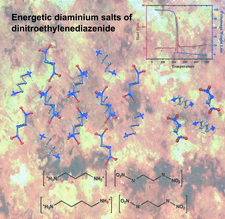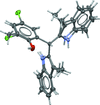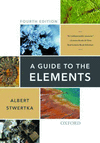issue contents
January 2019 issue

Cover illustration: Two novel energetic salts of ethylenedinitramine (EDNA) with alkanediamines have been crystallized and analyzed for their thermal properties. The extensive hydrogen-bonding networks in the energetic salts serve to improve their friction and shock sensitivity. See Roodt, Uprety, Levendis & Arderne [Acta Cryst. (2018), C74, 54-60].
research papers
Download citation


Download citation


The compound 4-phenyl-1-[phenyl(pyridin-2-yl)methylidene]semicarbazide crystallized as the E isomer due to the existence of weak π–π interactions between pairs of molecules. Its inorganic salts also crystallized as the E isomers, influenced by the establishment of hydrogen bonds involving the N—H groups of the cation and the water molecules and counter-ions (chloride, nitrate or thiocyanate). The calculated IR spectrum of the hydrated cation is in good agreement with the experimental results.
Download citation


Download citation


A new two-dimensional coordination polymer based on 5,5′-methylenebis(2,4,6-trimethylisophthalic acid) and 2,7-bis(1H-imidazol-1-yl)fluorene has been prepared and structurally characterized.
CCDC reference: 1875032
Download citation


Download citation


The [4]pseudorotaxane of β-cyclodextrin (β-CD) with coffee chlorogenic acid (CGA) is reported for the first time in CD inclusion complexes. The atomistic and thermodynamic insights of the trimodal and dimeric β-CD–CGA inclusion complexes are gained through single-crystal X-ray diffraction combined with DFT calculations.
CCDC reference: 1499415
Download citation


Download citation


The crystal structure of a heterocyclic molecule that exhibits an acceptor–acceptor–donor hydrogen-bonding pattern is reported, namely 2-aminoimidazo[1,2-a][1,3,5]triazin-4(3H)-one (trivially named P). P is part of an `artificially expanded genetic information system' (AEGIS). The crystal structure shows two tautomers of P packed in a Watson–Crick fashion cocrystallized in a 1:1 ratio.
CCDC reference: 1881877
Download citation


Download citation


This work reports a new acetonitrile-solvated cocrystal of piroxicam (PRX) and succinic acid (SA). The outcome of crystallization from acetonitrile can be controlled by varying only the PRX:SA ratio, with a higher PRX:SA ratio in solution unexpectedly favouring a lower stoichiometric ratio in the solid product.
CCDC reference: 1860488
Download citation


Download citation


Four novel isostructural lanthanide(III) coordination polymers based on a novel N-oxydic pyridyl naphthalenediimide ligand were synthesized and their crystal structures analysed. One of them demonstrates potential as an indirect band gap semiconductor material.
Download citation


Download citation


The electron-density-derived properties of the cocrystal of an antimalarial drug were studied using X-ray diffraction data collected at room temperature.
Download citation


Download citation


Two novel energetic salts of ethylenedinitramine (EDNA) with alkanediamines have been crystallized and analyzed for their thermal properties. The extensive hydrogen-bonding networks in the energetic salts serve to improve their friction and shock sensitivity.
Download citation


Download citation


The crystal structure of Co6(CO3)2(OH)8·H2O was solved ab initio and refined from synchrotron powder diffraction data.
CCDC reference: 1885213
Download citation


Download citation


Four 2,2′-bisindolylmethanes (BIMs) were synthesized and two were characterized crystallographically. These compounds show remarkably similar hydrogen-bonding motifs in the solid state.
Download citation


Download citation


In the structures of two chalcogenapentalene derivatives, 6-phenyl-6,7-dihydro-5H-2,3-dioxa-2aλ4-selenacyclopenta[hi]indene and 5-phenyl-5,6-dihydro-4H-benzo[c][1,2]oxaselenole-7-carbaldehyde, the former is stabilized by Se—O bonds, while in the latter, there is both an Se—Se bond and an Se⋯O interaction, which helps in the stabilization of the structure.
Download citation


Download citation


The statistically identical chiral architectures constructed from N—H⋯O and C—H⋯O hydrogen bonds are discussed for a pair of optical isomers belonging to the amidophosphoester family.
book reviews
Free 



 journal menu
journal menu






























